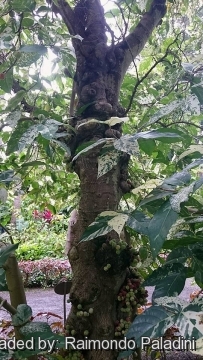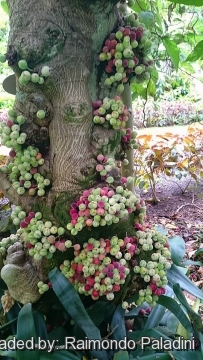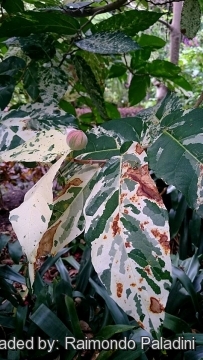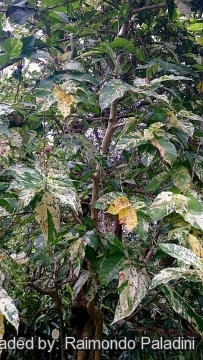= Ficus aspera f. parcellii (H.J.Veitch ex Cogn. & Marchal) J.E.Burrows
282. 2003
Accepted Scientific Name: Ficus aspera G.Forst.
Pl. Esc. 36 1786.

Ficus parcellii (Ficus aspera f. parcellii) Photo by: Raimondo Paladini
Fruiting habit at Puerto de la Cruz, Tenerife, Canary.
Origin and Habitat: New Hebrides islands, southwest Pacific.
Synonyms:
See all synonyms of Ficus aspera
back
Accepted name in llifle Database:Ficus aspera G.Forst.Pl. Esc. 36 1786.Synonymy: 7
back
Common Names include:
ENGLISH: Clown fig, Mosaic fig, , Tongue fig
Description: The wild form of Ficus asperaSN|33830]]SN|33830]] is a deciduous or evergreen, non-strangling "sandpaper" fig from the islands of the southwest Pacific, that usually grows to 3-4 m tall and 6 wide, but occasionally to 20 m tall, with villous, 3 cm diameter twigs. This shrub or small tree has large, roughly oval, deep-green leaves that are extremely rough, with an harsh surface and with rather hairy undersides.
Variegated form: The variegated cultivar, also known as Ficus asperaSN|33830]]SN|33830]] f. parcellii or Clown Fig, has a highly variable mosaic of paler grey-green, cream, and dull pink, on dark green leaves and a name that commemorates its discoverer Henry Parcel, a Sydney gardener who collected it in the South Seas on an expedition in 1869-70. Variegation is caused by a virus. This plant produces continually small marble-size, figs that are variegated with pink and purple markings instead of orange-red. This is one of the most beautiful figs.
Branchlets: Green or pink, slightly hairy; terminal buds to 1 cm.
Leaves: Papery. marbled, speckled or dotted ivory white or cream on dark green, distichous, margin coarsely and irregularly toothed or entire, slightly rough to the touch above, hairy beneath, thin, strongly asymmetric, ovate to oblong-ovate to elliptic, to 32-35 cm long and 15-18 cm broad, obtusely subacuminate, base very oblique, asymmetrically cordate, on 1-2 cm long petioles, light green, variegated and speckled with white. Lateral veins 7-9, raised beneath.
Figs (syconiums): Many in leaf axils or on older wood, and produced on warty tubercles. Male and female flowers are small and formed inside the syconium. Figs are globose, pubescent, 1.8 cm, green, often striped with white or pink; stalks to 1 cm.
Subspecies, varieties, forms and cultivars of plants belonging to the Ficus aspera group
Bibliography: Major references and further lectures:
1) Sean Hogan "Flora: A Gardener's Encyclopedia", Volume 1, Timber Press, 2003
2) “Botanica: The Illustrated A-Z of Over 10,000 Garden Plants and how to Cultivate Them” Mynah, 1997
3) James Cullen, Sabina G. Knees, H. Suzanne Cubey, J. M. H. Shaw “The European Garden Flora Flowering Plants: A Manual for the Identification of Plants Cultivated in Europe, Both Out-of-Doors and Under Glass” Cambridge University Press, 11 August 2011
4) Tovah Martin “The Unexpected Houseplant: 220 Extraordinary Choices for Every Spot in Your Home” Timber Press, 28 August 2012
5) Lim T. K. “Edible Medicinal And Non Medicinal Plants: Volume 3, Fruits” Springer Science & Business Media, 09 February 2012
6) Roger Spencer “Horticultural Flora of South-eastern Australia: Flowering Plants : Dicotyledons Part 1 : the Identification of Garden and Cultivated Plants, Volume 2” UNSW Press, 1995
7) Kunkel, “Flowering trees in subtropical gardens”, 55, 1978
8) Everett “The New York botanical gardens illustrated encyclopedia of horticulture” 4: 1366 & 1368 (1981).
9) “Graf, Exotica”, edn 11, 1563, 1573 & 2112A, 1982.
 Ficus aspera f. variegata. Fruiting habit at Puerto de la Cruz, Tenerife, Canary. (Ficus aspera f. parcellii) Photo by: Raimondo Paladini
Ficus aspera f. variegata. Fruiting habit at Puerto de la Cruz, Tenerife, Canary. (Ficus aspera f. parcellii) Photo by: Raimondo Paladini Ficus aspera f. variegata at Puerto de la Cruz, Tenerife, Canary. (Ficus aspera f. parcellii) Photo by: Raimondo Paladini
Ficus aspera f. variegata at Puerto de la Cruz, Tenerife, Canary. (Ficus aspera f. parcellii) Photo by: Raimondo Paladini Ficus aspera f. variegata. Fruiting habit at Puerto de la Cruz, Tenerife, Canary. (Ficus aspera f. parcellii) Photo by: Raimondo Paladini
Ficus aspera f. variegata. Fruiting habit at Puerto de la Cruz, Tenerife, Canary. (Ficus aspera f. parcellii) Photo by: Raimondo Paladini Ficus aspera f. variegata. Variegated leaves at Puerto de la Cruz, Tenerife, Canary. (Ficus aspera f. parcellii) Photo by: Raimondo Paladini
Ficus aspera f. variegata. Variegated leaves at Puerto de la Cruz, Tenerife, Canary. (Ficus aspera f. parcellii) Photo by: Raimondo Paladini Ficus aspera f. variegata. Variegated leaves at Puerto de la Cruz, Tenerife, Canary. (Ficus aspera f. parcellii) Photo by: Raimondo Paladini
Ficus aspera f. variegata. Variegated leaves at Puerto de la Cruz, Tenerife, Canary. (Ficus aspera f. parcellii) Photo by: Raimondo PaladiniSend a photo of this plant.The gallery now contains thousands of pictures, however it is possible to do even more. We are, of course, seeking photos of species not yet shown in the gallery but not only that, we are also looking for better pictures than those already present.
Read More... Cultivation and Propagation: Ficus asperaSN|33830]]SN|33830]] f. parcellii is a tropical species but can be cultivated in sub-temperate areas and is intolerant of frost. It is grown as a house plant in cool climates.
Exposure: It grows in full or partial sun, and indoors it need for bright light throughout the winteris a rare excepon in the fig group.
Soil: It needs well-drained, aerated soils.
Waterings: It is quite drought tolerant.
Salt tolerance: It can withstand salt spray.
Edible Parts and Uses: The ripe fruit is edible and is of local importance.
Hardiness: Overwinter at a minimum temperature of 18°c.Zones 11-12.














